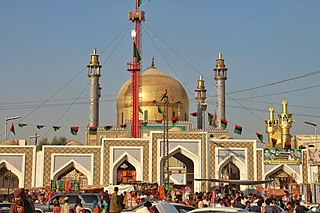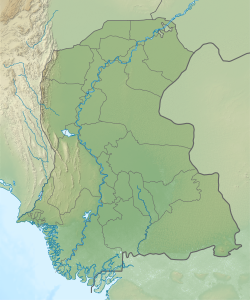
Sir Syed Ahmad Khan, also spelled Sayyid Ahmad Khan, was an Indian Muslim reformer, philosopher, and educationist in nineteenth-century British India.

A sandbag or dirtbag is a bag or sack made of hessian (burlap), polypropylene or other sturdy materials that is filled with sand or soil and used for such purposes as flood control, military fortification in trenches and bunkers, shielding glass windows in war zones, ballast, counterweight, and in other applications requiring mobile fortification, such as adding improvised additional protection to armored vehicles or tanks.
Badin is the main city and capital of Badin District in Sindh, Pakistan. It lies east of the Indus River. It is the 105th largest city in Pakistan. Badin is often called 'Sugar State' due to its production of sugar.

Sehwan is a historic city located in Jamshoro District of Sindh province in Pakistan situated on the west bank of the Indus River 80 miles (130 km) north-west of Hyderabad. The city is renowned for being the home of one of Pakistan's most important Sufi shrines, the Shrine of Lal Shahbaz Qalandar. The city also holds the status of taluka under the Jamshoro District. It was previously a part of the Dadu District; however, with the establishment of the Jamshoro District, Sehwan became linked with it.

Usman Marwandi, popularly known as Lal Shahbaz Qalandar, was a Sufi saint and poet who is revered in South Asia.
Agham Kot, historically known as Agham and today also called Aghamani or Aghamano, is a historical city and present-day ruin site located in Badin District, Sindh, Pakistan. It is located about 1.5 km northwest of the current town of Ghulab Khan Laghari, near the border with Hyderabad District. Said to be named after its 7th-century founder, the Lohana king Agham Lohana, Agham Kot historically lay on the right bank of the Dhoro, a branch of the Indus River that is now dried up. Because of this strategic location on an important waterway, Agham Kot was an important commercial centre in its heyday.

Thana Bulla Khan or Thano Bula Khan is a town and Taluka headquarter in Jamshoro District, Sindh, Pakistan. Thana Bula Khan Taluka.
The Kalhora dynasty was a Sindhi Muslim Kalhora tribe dynasty based in the region of Sindh, present day Pakistan. The dynasty governed much of Sindh and parts of Kutch between 1701 and 1783 from their capital of Khudabad, before shifting to Hyderabad from 1768 onwards. They were assigned to hold authority by the Mughal Grand Vizier Mirza Ghazi Beg.

Shah Inayatullah, popularly known as Sufi Shah Inayat Shaheed, Shah Shaheed or Shah Inayat of Jhok, was a 17th-century Sindhi Sufi saint and revolutionary from Jhok. He was the first socialist and agricultural reformist of Sindh.

Badi' al-Zaman Mirza was a Timurid ruler of Herat from 1506 to 1507. He was the son of Husayn Bayqarah, who was a great-great-grandson of Timur.
The Aligarh Movement was the push to establish a modern system of Western-style scientific education for the Muslim population of British India, during the later decades of the 19th century. The movement's name derives from the fact that its core and origins lay in the city of Aligarh in Central India and, in particular, with the foundation of the Muhammadan Anglo-Oriental College in 1875. The founder of the oriental college, and the other educational institutions that developed from it, was Sir Syed Ahmed Khan. He became the leading light of the wider Aligarh Movement.
Sindh Land Alienation Bill of 1947 was a piece of legislation introduced by the British Sindh Assembly, with the aim of returning the mortgaged land to the owners, Similar to the Punjab Land Alienation Act of 1900.
Talti is a town and union council in Sehwan taluka of Jamshoro District, Sindh. It is located in the historical pargana of Baghban, 8 miles north of Sehwan and 2 miles off the main road from Sehwan to Larkano. It also has road connections with nearby Bhan and Bubak. There is a dhandh near Talti that is used as a source of fishery.
Bubak is a town and union council in Sehwan taluka of Jamshoro District, Sindh. It is located on the northeastern shore of Lake Manchar, 9 miles west of Sehwan. Besides Sehwan, it is connected by road with Bhan and Talti.
Unarpur is a village and deh in Manjhand taluka of Jamshoro District, Sindh. It is located close to the west bank of the Indus river, across from Matiari, on the main road from Kotri to Sehwan. As of 2017, Unarpur has a population of 4,092, in 891 households. It is the seat of a tappedar circle, which also includes the villages of Belo Unerpur, Budhapur, Nai Jetharo, and Wachero.
Kakrala was a historical region in southern Sindh, in the coastal parts of the Indus Delta. Descriptions of its precise extent vary, but it lay in the middle part of the delta, comprising the present-day taluqas of Shahbandar and Jati in Sujawal and Thatta districts. It has been described as the region from Jati to Kharo Chan, or the region between the mouths of the Wanyani and Pitti rivers. This area later formed part of the pargana of Ghorabari.
Chandūka, also spelled Chāndkoh or Chāndko, was a historical region in Sindh, roughly corresponding to the Larkana subdivision as it existed in the early 20th century. It was an alluvial tract on the right bank of the Indus with its main town at Ghaibi Dero. S.H. Hodivala also wrote in 1939 that Chanduka was then the name of the main town in Larkana District. Chanduka is named after the Baluch tribe known as the Chandias.
Babbar, Babur, Babar is a Baloch tribe which lives in Northern Sindh, Makran and Dera Ghazi Khan division of Punjab. The Mughal author "Yūsuf Mīrak" described the Babbars in his historical account of Sindh the "Tareekh E Mazhar Shah Jahani", as a rebellious Baloch tribe inhabiting the Kirthar mountains westwards of present day Jamshoro district of Sindh.

Mirza Jani Beg Tarkhan was the last Sultan of Sindh. He succeeded his grandfather Mirza Muhammad Baqi after his death. He ruled from 1585 to 1591 as an independent monarch of Sindh but was forced to submit to Mughal authority. He later involuntarily abdicated in 1593 and a Mughal Subahdar was appointed in his place. But due to social and public unrest, the Mughal authority appointed Jani in his place in 1594. Jani continued to serve as the Mughal Subahdar till his death in 1601.
The Numria,Noomria or Nuhmardi are native Sindhi Rajput tribes of Sindh and Balochistan. The Numria people are principal inhabitants of the Lasbela and Kohistan regions.









